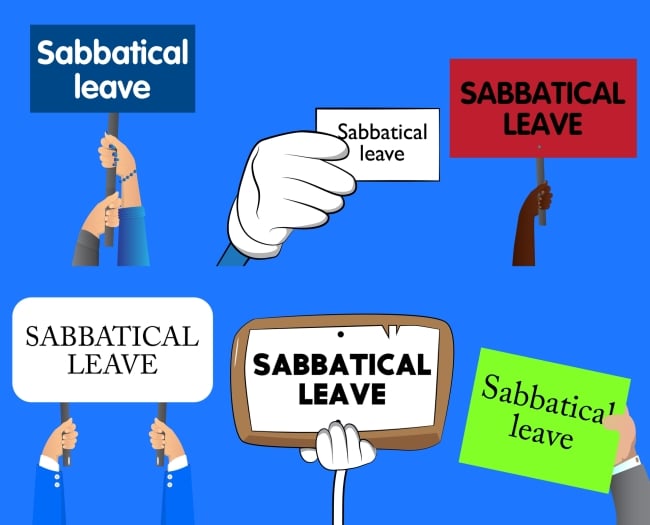You have /5 articles left.
Sign up for a free account or log in.

NoraVector/iStock/Getty Images Plus
These past few months, I was fortunate that my academic position provided space for a sabbatical experience with some colleagues at Harvard Medical School and Stanford University. I expanded my scholarship, learned new pedagogical approaches, discovered new learning spaces and environments, created new partnerships, and strengthened relationships with colleagues and friends.
Throughout that experience, I also discovered the importance of taking a break from the usual work environment to explore other spaces that can help develop the mind and the soul. But what if you can’t take a formal sabbatical like I did to refresh and reinvigorate yourself and your research? How might you obtain a fresh perspective on the same scientific problem or humanities research you have been working on for years?
Recently, when I’ve had conversations with students and other career professionals, some have asked me the following questions.
- I am getting tired of the same work every day. How can take my mind elsewhere but not remove myself from the project completely?
- I want some fresh ideas and I only see the same people at the same meetings—how do I expand the network?
- How do I incorporate some of my current and perhaps new hobbies and interests into my thought leadership development for my career?
- How do I keep the job deliverables for my current work and grow myself?
All those questions spring from one foundational question: How might I experience something like what one might call a “thought sabbatical”—a time for intellectual and personal growth and reflection—even though it is not a formal part of my program?
To answer that question, perhaps reflect upon the specific why: what you hope to take away from such an experience. Here are some examples that students, postdoctoral fellows or career professionals have shared with me.
- I want a fresh perspective on the same scientific problem I have worked on for years.
- I want to see how another organization might tackle this scientific problem or educational program.
- I want to see what an interdisciplinary approach would look like to my research question.
- I want to see how a different environment might have different approaches to the science, social, humanities or arts issue.
- I have been in my discipline for so long. I feel like I am looking for a needle in a haystack. I want to view the haystack. In fact, I want to see the field the haystack sits in. It may be helpful in finding the answers if I could see if from a distance or through another lens.
- I have another interest that drives me and would like to focus on that and combine them together.
Then, after conversations with your direct research supervisor, try to discuss your ideas with the members of your committee as a group as well as one on one, over coffee, lunch or a walk. Bring questions, collect ideas, ask more questions. Talk again with your supervisor. Reach out to your peers over social hour, during a meal, on a walk or around the campfire at the departmental retreat.
Share your work with peers, collaborators or mentors at different universities, as they might have different resources or infrastructures you never thought of. Also, seek out people who are not in your discipline, but who understand the scientific or humanities process and your specific goals, to obtain a different view of the problem. They may ask questions such as, “Why are using this method?” or “Why are you studying this specific question?” These types of broad questions could also make you see your research in a new light and come up with other potential approaches or solutions.
Suggestions and Possible Action Items
After gathering such information and ideas, you can return to the initial questions better prepared to answer them in some detail.
No. 1: I am getting tired of the same work every day. How can take my mind elsewhere but not remove myself from the project completely? Consider reframing the work you do every day so it is not the “same.” For example, a colleague was having difficulty with a new move, as the commute to her workplace had been extended to an hour. After some thought and discussion with some friends, she now bikes on sunny days and listens to her favorite audiobooks in the car on rainy ones. In other words, she is not removing herself from the project of commuting to work but rather taking her mind elsewhere.
How might you apply this approach in the context of science or research? Identify what makes the task tiring and try to change that. Do you need to add some music while you work? If you are reading, how about moving to another library? How about recording your work and posting it on a vlog for yourself?
Or could you break up your work with a workout/run/swim in between? Could you have a student mentee shadow you so you can teach them your thought process? Could you hire some work-study students or fellows and advise and mentor them through a method or experiment? That way, you can delegate and mentor while still accomplishing your goals.
No. 2: I want some fresh ideas and I only see the same people at the same meetings—how do I expand the network? Seek out people and events farther afield that relate to your research and human interests. For example, if you are an immunologist, your annual meeting may be at the Canadian Society of Immunology, but try to see if your work can be presented at other conferences, such as the International Congress of Medicine, so that your work can be shared with a broader audience. You will be able to meet other scientists who may provide another perspective or even a potential interdisciplinary collaboration. If you usually attend the environmental writing conference, perhaps attend a broader convention for multiple genres to open up your perspective.
Apart from conferences, you may also reach out to others with common interests through student or disciplinary societies, organizations, LinkedIn, the mentorship community from your alma mater such as 10,000 Coffees or Graduway. Request informational interviews. For example, if you were trying to initiate a leadership program at your university, ask them how they implemented theirs, what challenges they faced and what advice they would have.
No. 3: How do I incorporate some of my hobbies and interests into my thought leadership development? Many students and career professionals have interests outside of their primary discipline, and fostering such hobbies may also contribute to your leadership and skill development in ways that can be applied to your career pathway. For example, a scientist physician who is also an avid violinist promotes and implements workshops for medical and research students about the importance of the arts and humanities in the scientific enterprise.
No. 4: How do I keep the job deliverables for my current work and grow myself? Your “thought sabbatical” does not need to be at a different location, if that is not feasible. You do not need to leave your current job. As mentioned in these examples, you can find the resources to experience sabbatical-like shorter experiences interwoven within your current work. With the right amount of imagination, reflection, career goal-setting, network and logistics, you can design a sabbatical-like experience to enhance your current experience, even if it not a formal part of your curriculum or career pathway. It will just take some creativity and a network of professionals and mentors to help guide your idea into reality.
My Sabbatical Story
The designing of my sabbatical started many years before it began. My interests in career and professional development for undergraduate students, graduate students and postdoctoral fellows led me to attend and present at relevant national meetings, reach out to career professionals for informational interviews via LinkedIn and emails, and write pertinent articles and a book.
Through several years of those activities, I approached colleagues whom I had built relationships with at various universities with ideas to work on during a sabbatical. Those colleagues helped me connect with the individuals who could help make the sabbatical a reality from the logistical perspective. From my experiences away, I gained an invaluable view on how other universities run their programs, obtained pedagogical tools and tips to bring to my current job, expanded my thoughts about the world and work, and most important, built a stronger community of people who can learn from each other now and into the future.
I am fortunate that my home university provides an official sabbatical time to be away and learn from colleagues at other universities, and I certainly recognize that not everyone has that luxury. But, even so, I hope that some of the suggestions I’ve provided can inspire and help you to create a sabbatical-like experience that enriches your own career and life.




